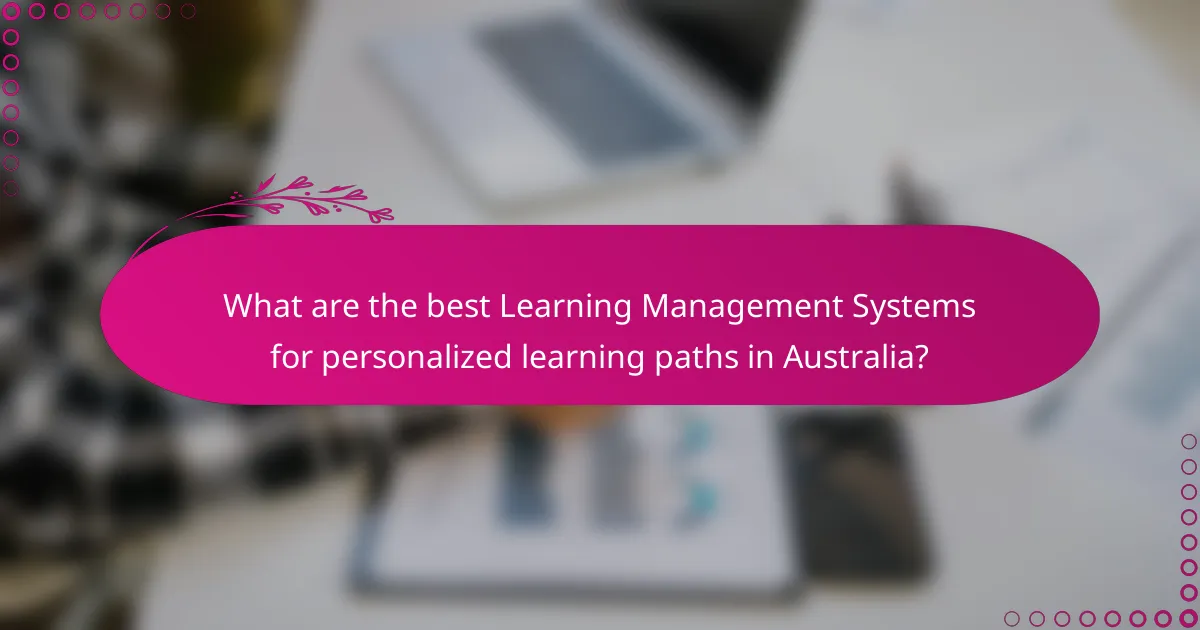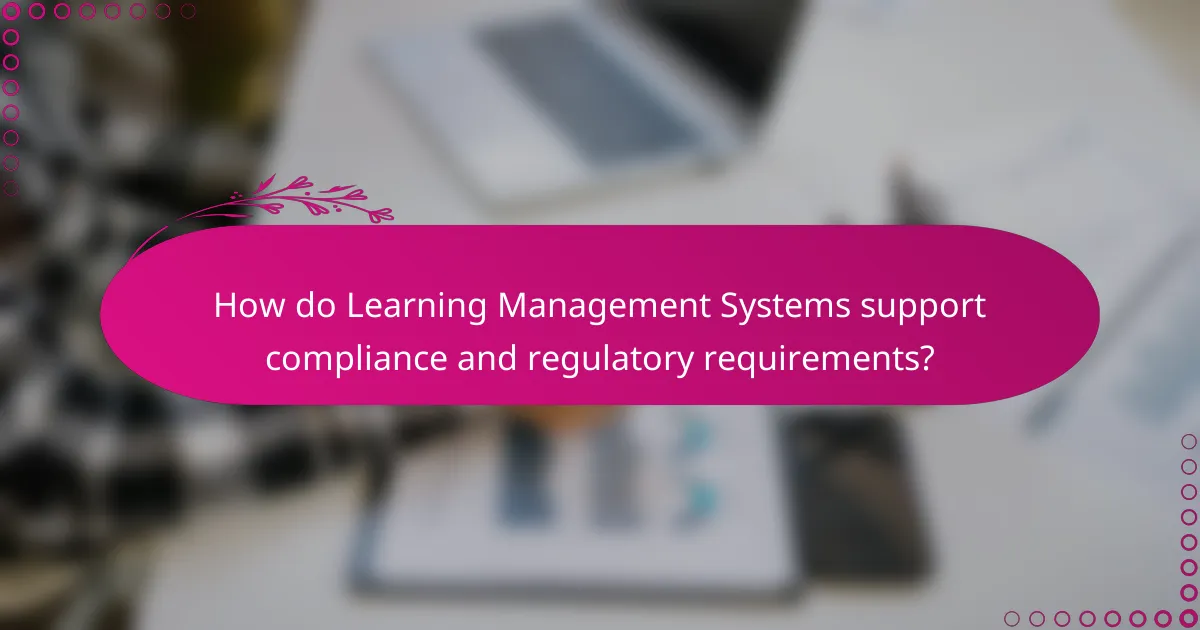Learning Management Systems (LMS) are revolutionizing education by offering personalized learning paths and advanced skill tracking capabilities. These platforms empower educators to design tailored experiences that meet individual student needs, fostering greater engagement and effectiveness. Additionally, LMS solutions provide significant cost efficiencies by automating administrative tasks and streamlining training processes, ultimately saving organizations time and resources.

What are the best Learning Management Systems for personalized learning paths in Australia?
The best Learning Management Systems (LMS) for personalized learning paths in Australia include platforms that offer tailored content and skill tracking features. These systems enable educators to create customized learning experiences that cater to individual student needs, enhancing engagement and effectiveness.
Moodle
Moodle is an open-source LMS widely used in Australia, known for its flexibility and customization options. It allows educators to create personalized learning paths through its activity completion settings, enabling students to progress at their own pace based on their skills and knowledge.
Key features include the ability to track learner progress and generate reports, which helps in assessing individual performance. Moodle’s extensive plugin library also allows for additional functionalities, making it adaptable to various educational contexts.
Canvas
Canvas is a cloud-based LMS that emphasizes user-friendly design and robust features for personalized learning. It supports adaptive learning paths by allowing instructors to customize course materials based on student performance and preferences.
With its analytics tools, educators can easily monitor student engagement and success, making it easier to adjust learning paths as needed. Canvas also integrates well with other educational tools, enhancing its functionality for personalized learning.
TalentLMS
TalentLMS is a versatile LMS that focuses on skill tracking and personalized learning experiences. It offers a straightforward interface and allows for the creation of tailored learning paths that align with specific skills or competencies.
One of its strengths is the ability to automate training assignments based on learner progress, ensuring that users receive the right content at the right time. TalentLMS is particularly suitable for corporate training environments, where skill development is crucial for employee performance.
![]()
How do Learning Management Systems enhance skill tracking?
Learning Management Systems (LMS) enhance skill tracking by providing tools that monitor learner progress and performance in real-time. These systems allow educators and organizations to assess skills development, identify gaps, and tailor learning experiences accordingly.
Real-time progress monitoring
Real-time progress monitoring enables instructors and learners to view current performance metrics instantly. This feature allows for timely interventions when a learner struggles with specific skills or concepts, ensuring that support can be provided without delay.
For example, an LMS can track completion rates of courses or modules, quiz scores, and participation levels. By visualizing this data through dashboards, both learners and educators can quickly identify areas needing improvement.
Customizable reporting features
Customizable reporting features in an LMS allow users to generate tailored reports that focus on specific skills or competencies. This flexibility helps organizations align training programs with their strategic goals and individual learner needs.
Reports can include various metrics, such as skill acquisition rates, time spent on tasks, and overall performance trends. By adjusting the parameters of these reports, educators can gain deeper insights into learner progress and make informed decisions about future training initiatives.

What are the cost efficiencies of using Learning Management Systems?
Learning Management Systems (LMS) offer significant cost efficiencies by streamlining training processes and reducing overall expenses. By automating administrative tasks and providing scalable solutions, organizations can save on both time and resources.
Reduced training costs
Implementing an LMS can lead to reduced training costs by minimizing the need for in-person sessions and printed materials. Organizations can deliver training online, which cuts travel expenses and venue costs. For example, companies can save hundreds to thousands of dollars per training session by utilizing virtual classrooms instead of traditional settings.
Additionally, LMS platforms often include features such as automated assessments and reporting, which further decrease the administrative burden. This allows training teams to focus on content quality rather than logistics, ultimately leading to more effective learning experiences.
Scalable subscription models
LMS providers typically offer scalable subscription models that allow organizations to pay only for what they need. This flexibility means that businesses can start with a basic plan and upgrade as their training requirements grow, making it easier to manage budgets. Subscription costs can range from a few dollars per user per month to more comprehensive packages depending on features and support.
Moreover, many LMS platforms provide tiered pricing based on the number of users or features required. This allows organizations to tailor their spending according to their specific needs, ensuring that they are not overpaying for unused capabilities. It’s essential to evaluate the features included in each tier to find the best fit for your training goals.

What criteria should be considered when selecting a Learning Management System?
When selecting a Learning Management System (LMS), consider factors such as user interface, integration capabilities, personalized learning paths, skill tracking, and cost efficiency. These criteria will help ensure that the LMS meets the specific needs of your organization and enhances the learning experience for users.
User interface and experience
The user interface (UI) and overall experience are critical for the success of an LMS. A clean, intuitive design encourages user engagement and reduces the learning curve for new users. Look for systems that offer customizable dashboards and easy navigation to enhance usability.
Consider conducting user testing with potential learners to gather feedback on the interface. This can help identify any pain points or areas for improvement before fully implementing the system. A well-designed UI can significantly impact user satisfaction and retention rates.
Integration capabilities
Integration capabilities determine how well the LMS can connect with existing tools and systems. Look for an LMS that supports integration with popular applications such as HR systems, content libraries, and communication tools. This ensures a seamless flow of data and enhances the overall learning experience.
Evaluate the ease of integration and the types of APIs available. A flexible LMS that can adapt to your organization’s tech stack will save time and resources in the long run. Prioritize systems that offer robust support for third-party integrations to maximize functionality and efficiency.

How do Learning Management Systems support compliance and regulatory requirements?
Learning Management Systems (LMS) play a crucial role in ensuring compliance with various regulatory requirements by providing tools for tracking, reporting, and managing training programs. They help organizations maintain necessary certifications and streamline the audit process, ensuring adherence to industry standards.
Tracking certifications
Tracking certifications is essential for organizations to ensure that employees meet required qualifications. An LMS can automate the monitoring of certification statuses, sending reminders for renewals and providing a centralized repository for all certification records.
For example, if a company requires its staff to hold specific safety certifications, the LMS can alert managers when a certification is nearing expiration, allowing timely renewals. This proactive approach helps avoid compliance issues and potential fines.
Automated reporting for audits
Automated reporting features in an LMS simplify the audit process by generating comprehensive reports on training completion, certification status, and compliance metrics. These reports can be customized to meet specific regulatory requirements, making it easier to present necessary documentation during audits.
Organizations can benefit from setting up regular automated reports, which can be scheduled weekly or monthly, ensuring that compliance data is always up-to-date. This reduces the administrative burden and enhances transparency in training practices.

What are the emerging trends in Learning Management Systems?
Emerging trends in Learning Management Systems (LMS) focus on enhancing user engagement and effectiveness through advanced technologies and methodologies. Key developments include AI-driven personalized learning, mobile learning enhancements, and gamification, all aimed at improving the learning experience and outcomes.
AI-driven personalized learning
AI-driven personalized learning tailors educational experiences to individual needs, preferences, and learning speeds. By analyzing user data, these systems can recommend specific courses, resources, or learning paths that align with a learner’s goals and skills.
For instance, an LMS might suggest advanced modules for a user excelling in a subject while offering foundational resources to those struggling. This customization can significantly enhance engagement and retention rates, making learning more efficient.
Mobile learning enhancements
Mobile learning enhancements allow users to access educational content anytime and anywhere, making learning more flexible and convenient. With the increasing use of smartphones and tablets, LMS platforms are optimizing their interfaces for mobile devices, ensuring a seamless experience.
Features such as offline access, push notifications for reminders, and interactive mobile-friendly content are becoming standard. This trend is particularly beneficial for learners in remote areas or those balancing education with work commitments.
Gamification of learning experiences
Gamification incorporates game-like elements into learning environments to boost motivation and engagement. By using points, badges, leaderboards, and challenges, LMS platforms create a more interactive and enjoyable learning experience.
For example, learners might earn points for completing modules or receive badges for mastering specific skills. This approach not only makes learning fun but also encourages healthy competition and collaboration among peers, leading to improved outcomes.

How can Learning Management Systems improve employee engagement in Australia?
Learning Management Systems (LMS) can significantly enhance employee engagement in Australia by providing personalized learning paths and skill tracking. These systems facilitate tailored training experiences that align with individual employee needs and organizational goals, fostering a more motivated and skilled workforce.
Interactive content delivery
Interactive content delivery is a key feature of LMS that keeps employees engaged by making learning more dynamic. This can include quizzes, simulations, and gamified elements that encourage active participation. For example, an LMS might offer scenario-based training where employees can make decisions and see the outcomes, which enhances retention and application of knowledge.
To maximize effectiveness, organizations should ensure that interactive content is relevant to the employees’ roles and is updated regularly. Incorporating feedback mechanisms can also help in refining the content based on user experience, making it more engaging over time.
Social learning features
Social learning features in LMS promote collaboration and knowledge sharing among employees, which can enhance engagement. These features may include discussion forums, peer reviews, and social media integrations that allow employees to connect and learn from each other. For instance, a platform might enable employees to share insights on projects or participate in group challenges, fostering a sense of community.
To effectively implement social learning, organizations should encourage participation by recognizing contributions and creating a culture that values collaboration. Providing clear guidelines on how to engage in these features can also help employees feel more comfortable and motivated to participate.